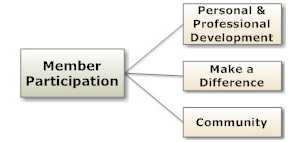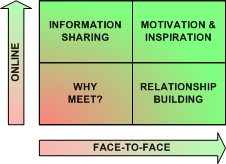Meeting people at networking events is a great way to grow your professional network of connections — plus increase the frequency of visiting with people you already know.
People who share a common interest, problem, or profession benefit from spending face-to-face time with like-minded people.
You know networking is great — however, there are times when you can't find a well-matched networking group near you that meets your needs.
Solve this networking dilemma — when there's no networking group near you, start one.
Benefits of starting a networking group
Starting and running a networking group is a lot of work, so you need to think about how you will not only spend the time necessary, but benefit from your time investment.
A few years ago a few friends and I started a networking group because we wanted to network with other entrepreneurs like us, and there was no group in our area. Some people start a networking group to turn it into a business, while others start a networking group that's part of their existing business. And yes, some want the social benefits.
The three Ps of a networking group
There are the essential ingredients to a successful networking group:
- Purpose — How will attendees benefit from attending meetings and making new contacts? Is there a "passion" that will encourage participation?
- People — What common interest or need will hold your community together?
- Place — Where will your networking group meet that attendees will find comfortable and convenient?
- Promotion — How will you reach out to new people in the area who share an interest in the networking group's purpose for meeting?
Mission and purpose
Here are several leadership questions that will help you create a clear picture of what your networking group will accomplish:
- What interest will your attendees and members have in common?
- How will people benefit by attending your networking events?
- How will people meet new contacts that will lead to beneficial relationships?
There are a wide variety of networking groups, such as:
- Business and social networking group — People who want to socialize and form relationships with others in their specific profession or industry.
- Networking leads and referral group — Salespeople and business development people who work together to help their customers.
- Job leads group — People who share job opportunities with others who are looking for a job.
In addition to helping the people who attend your networking meetings, think about how you will benefit, too. It takes a lot of time and work to start and run a networking group, and you need to think about how you will benefit from taking on this leadership role. If you don't receive a reasonable return on your invested time and money - chances are you will burn out before the group can reach critical mass.
Networking needs people
Every networking group needs several types of people:
- Founders — People who lead, plan, and recruit others to attend.
- Supporters — People who help the networking group grow and thrive by inviting their contacts to meetings, making introduction, and, in some cases, sponsor networking meetings and special events.
- Attendees — People who attend the meetings, participate, and engage with other who are looking to network and create mutually beneficial relationships.
Networking groups need programs
Many networking groups get started with the idea that people will just naturally attend and mingle and meet people. This can work well in the early days when the founders and supporters invite people they know and who have a core shared interest in socializing.
However, as the group grows, it helps to have a "program" that attracts new people to attend. Each meeting's program also shapes and develops the common interest of the people attending each meeting — new people know that those who share an interest in the programs topic will attend.
The typical program at most networking groups, association chapters, and other interest groups is a guest speaker from outside the group. However, there are several other types of program formats, such as:
- Featured member presentation
- Every attendee makes a mini-presentation
- Every attendee participates in a "speed networking" activity where everyone meets everyone else one-to-one
Places to network
Finding a location for a new networking group to meet is usually easy, but it becomes more difficult as the group attracts more attendees.
New networking groups normally start by meeting at free locations, such as:
- Conference room at a member's office
- Coffee shop
- Restaurant
- Lobby of a large hotel
An example of location used by a lot of small and casual networking groups is their nearest Panera Bread location. Their locations have plenty of room, good coffee and snacks, and free WiFi!
Free locations like these allow a networking group to avoid charging for attendance. Each person just pays for whatever they eat or drink.
However, as the number of people who attend increases, it will become necessary to contract with venues that handle larger meetings and events. This means that the organizers need to pay for the room, and for the food and drinks provided to attendees. And, this means that attendees need to pay to attend the networking events. Collecting fees can be handled by either having people register online before the event or pay at the door.
Promoting a networking group's meetings
Networking groups thrive when there is a mix of regular attendees who frequently attend plus new, interested people at each event — and this takes promotion.
Some networking groups try to promote their meetings by just posting a notice on their Web event calendar and sending a personal e-mail to the people in their contact list. This doesn't work well because it usually doesn't reach a significant number of people who might attend, and it doesn't remind people frequently enough to break through the clutter of media overload.
The very best way to promote a networking event to your core participants is to send several e-mails to everyone who has attended in the past. The easiest way to do this is to use an online meeting promotion and RSVP service, such as SureToMeet.
Networking groups need to attract new people to attend, participate, and become loyal members. This is effectively achieved by promoting the group's meetings and events in several ways:
- Referrals — Make it easy for previous attendees to invite their friends and associates.
- Social media — Post announcements on social media sites where like-minded followers and friends can click through to the event Web page and RSVP.
- Traditional and online media — Post announcements on Web calendar sites, and send announcements to local newspapers with calendar sections.
- Sign-up form — Make it easy for people to subscribe to your meeting notices with an online registration form.
Planning the new networking group
Each of the start-up elements of starting and growing a networking group has a lot of details, so to make your networking debut easier for you, we've created an interactive planning tool for starting and running a networking group. Just start at the top level of the interactive mind map, and drill down to the specific action items and tasks that will help you create your networking group's meetings and events.




